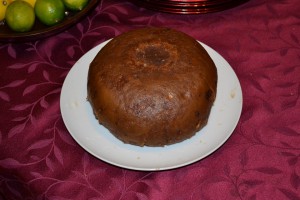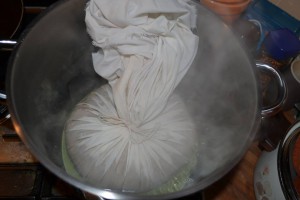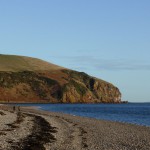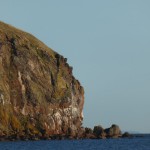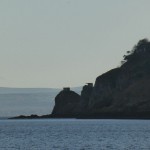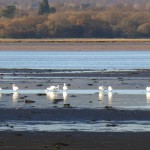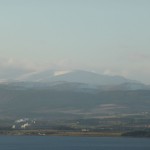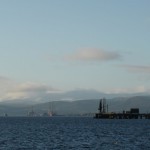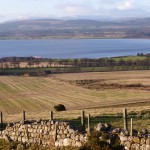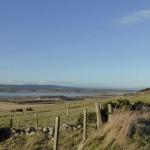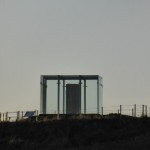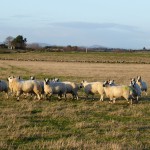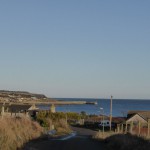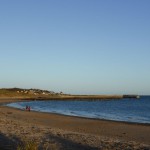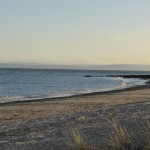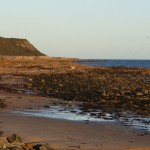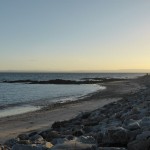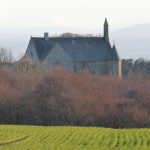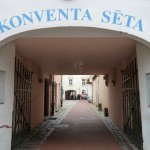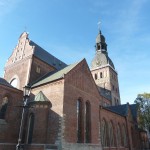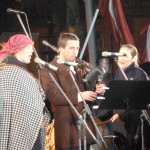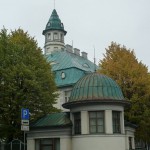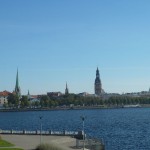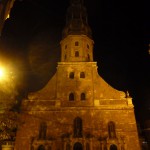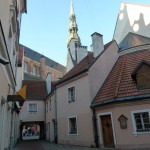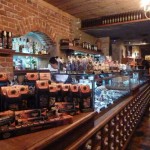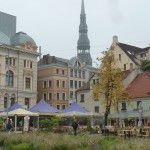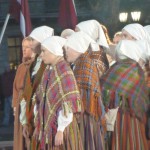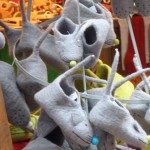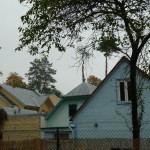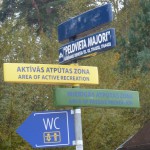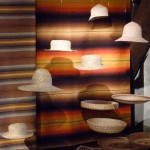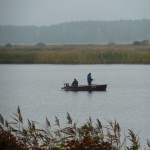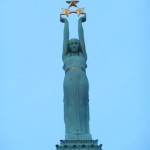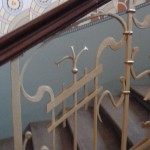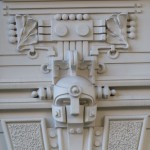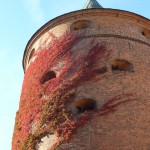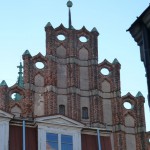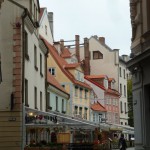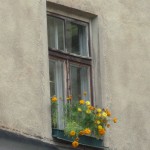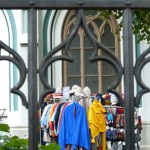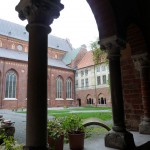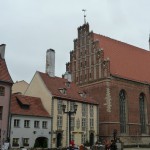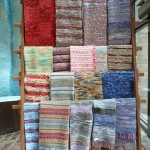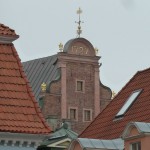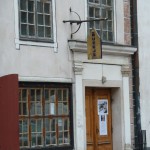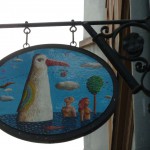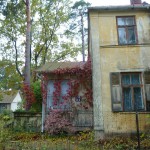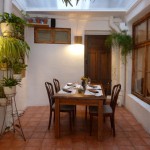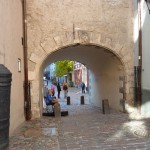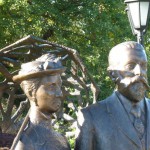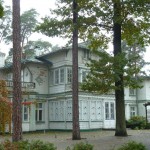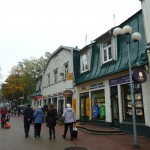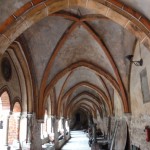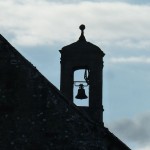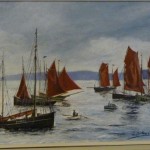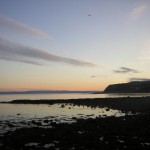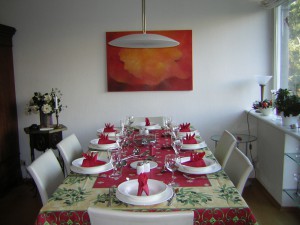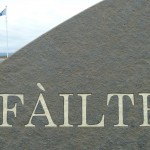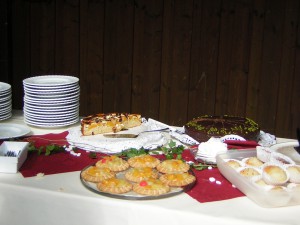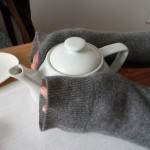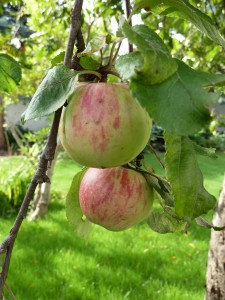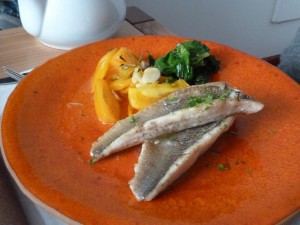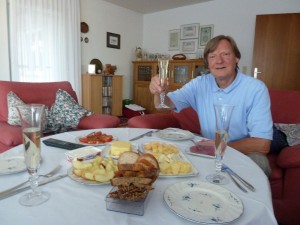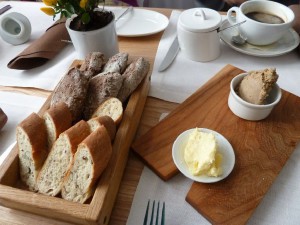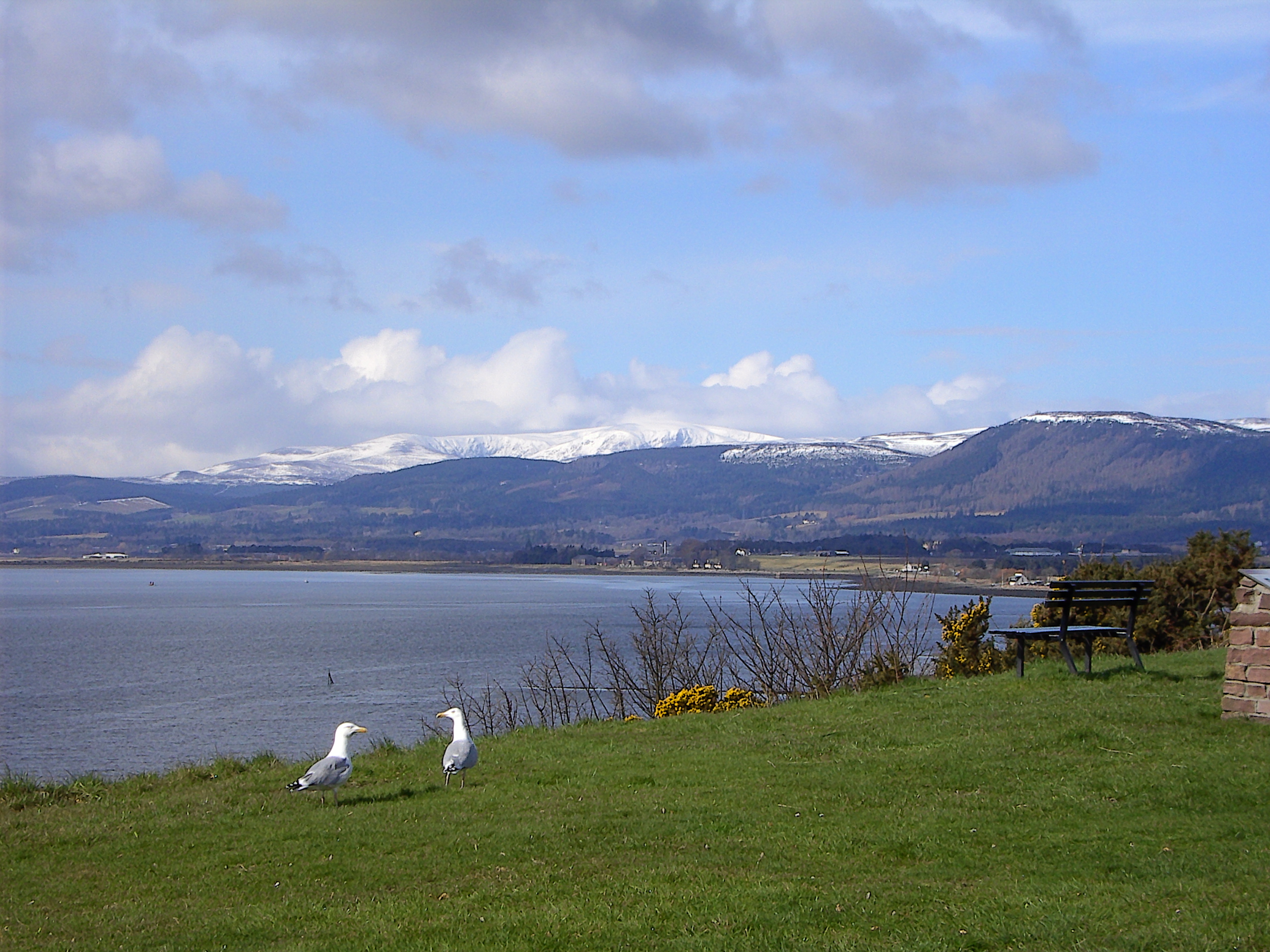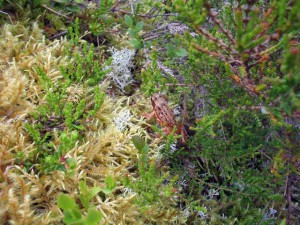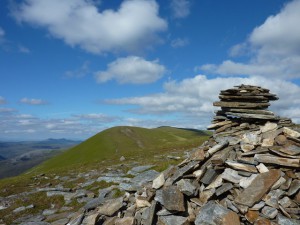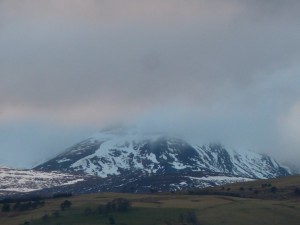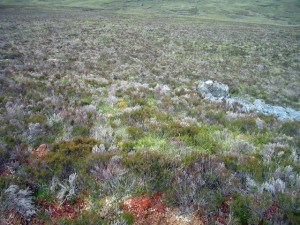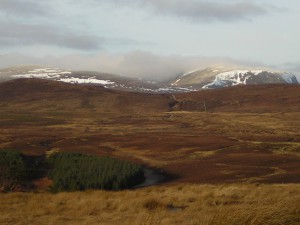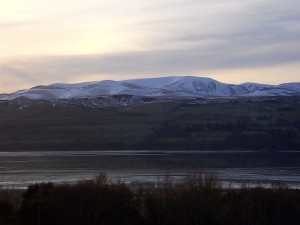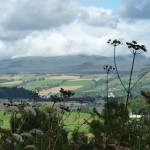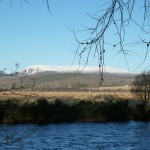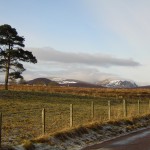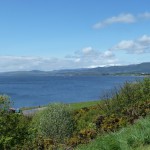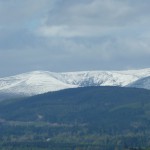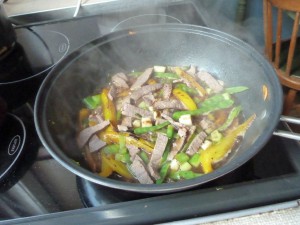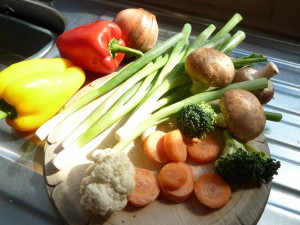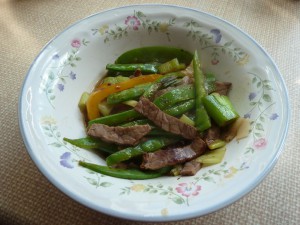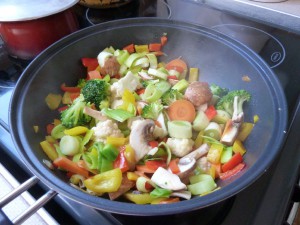Cnoc Fhaoighris
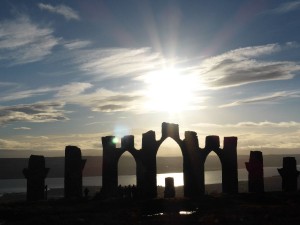 Sgrìobh mi mu Bheinn Uais mìos no dhà air ais, agus a-nis ‘s ann aig Cnoc Fhaoighris a tha an turas: an cnoc ainmeil, 1478 tròigh a dh’àirde, leis a’ charragh-cuimhne air a mhullach, a tha ri fhaicinn air cùl Bhaile Eòghainn agus Alanais. Bha an darna latha den Fhaoilleach uabhasach brèagha am bliadhna agus choisich mi dhan mhullach còmhla ri chàirdean. Cha robh sinn idir nar n-aonar – a rèir choltais bha an darna leth muinntir Rois an Ear den bheachd gun do dh’ith ‘s do dh’òl iad fada cus rè na seachdain a dh’fhalbh, agus bha iad a’ dèanamh feum dhen t-sìde bhrèagha gus beagan àile ghlain agus eacarsaich fhaighinn. No a’ toirt gu buil aon de na rùintean na Bliadhn’ Ùir aca, ‘s dòcha?
Sgrìobh mi mu Bheinn Uais mìos no dhà air ais, agus a-nis ‘s ann aig Cnoc Fhaoighris a tha an turas: an cnoc ainmeil, 1478 tròigh a dh’àirde, leis a’ charragh-cuimhne air a mhullach, a tha ri fhaicinn air cùl Bhaile Eòghainn agus Alanais. Bha an darna latha den Fhaoilleach uabhasach brèagha am bliadhna agus choisich mi dhan mhullach còmhla ri chàirdean. Cha robh sinn idir nar n-aonar – a rèir choltais bha an darna leth muinntir Rois an Ear den bheachd gun do dh’ith ‘s do dh’òl iad fada cus rè na seachdain a dh’fhalbh, agus bha iad a’ dèanamh feum dhen t-sìde bhrèagha gus beagan àile ghlain agus eacarsaich fhaighinn. No a’ toirt gu buil aon de na rùintean na Bliadhn’ Ùir aca, ‘s dòcha?
Tha fios aig a’ mhòrchuid againn air cnàmhan lom sgeul a’ charraigh-chuimhne – an Rìdire Eachann Rothach à Taigh an Fhuamhair agus an “cothrom-obrach” tuigseach aige san 18mh linn – ach ma bhios sinn a’ dèanamh beagan rannsachaidh, tha cùl-fiosrachaidh mòran nas inntinniche ann, ceangailte rin Rìdire fhèin agus ri tachartasan cudromach ann an eachdraidh na linn sin.
Rugadh Eachann Rothach mu 1725, agus mar dhuine òg à mion-mheur nan Rothach bha e na shaighdear cumanta air taobh nan Hanobharach an aghaidh nan Seumasach. Aon oidhche, le tuiteamas, shàbhail e a’ Bhan-diùc Ghòrdain nuair a bha an gille-greasaidh aice fo mhisg; a rèir choltais chuidich i e comisean rèisimeideach fhaighinn mar thaing, agus mar sin thòisich an dreuchd fhada ainmeil aige san arm, a’ mhòrchuid dhith sna h-Innseachan, gus leas malairt na h-Ìmpireachd (agus an East India Company) a dhìon an aghaidh nam Frangach.
Mar cheannard a’ Bhengal Presidency Army chuidich e ceannairc nan sepoys (saighdearan Innseanach) a chur sios ann an 1764, agus sin gu spraiceil: ” No believer in taking a soft line Munro decided that the only way to deal with the sepoys, whether their grievances were justified or not, was to execute the ringleaders in typical EIC fashion – by tying them to the wheels of a cannon and blowing them apart. He also disbanded the most rebellious native regiment.” http://scottishmilitary.blogspot.co.at/2011/08/sir-hector-munro-whos-who-in-scottish.html
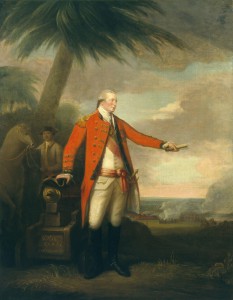 Ann an 1765 bhuannaich e a’ bhuaidh a bu mhòtha aige aig Buxar, anns a bhith a’ cur cath-innleachd air leth an gnìomh, le ach 7,000 daoine an aghaidh 40,000 saighdearan Mughal. Leis an airgead-duais leig e dheth an comisean aige agus thill e na ghaisgeach a Bhreatainn, far an do cheannaich e roinn-taghaidh ‘Inverness Burghs’ ann am Pàrlamaid agus thàinig e a dh’fhuireach aig Taigh an Fhuamhair, a fhuair e mar dhìleab bho uncail.
Ann an 1765 bhuannaich e a’ bhuaidh a bu mhòtha aige aig Buxar, anns a bhith a’ cur cath-innleachd air leth an gnìomh, le ach 7,000 daoine an aghaidh 40,000 saighdearan Mughal. Leis an airgead-duais leig e dheth an comisean aige agus thill e na ghaisgeach a Bhreatainn, far an do cheannaich e roinn-taghaidh ‘Inverness Burghs’ ann am Pàrlamaid agus thàinig e a dh’fhuireach aig Taigh an Fhuamhair, a fhuair e mar dhìleab bho uncail.
Bho shin a-mach thug e ùine gu “leasachaidhean” air an oighreachd, mar a bha am fasan aig an àm. Bha am fearann an sin neo-thorrach, gun chraobhan, agus gun mòran chothroman-obrach do mhuinntir na sgìre, agus anns an ath dheichead dh’atharraich Eachann cruth nan taighean agus an fhearainn gu tur, le leasachaidhean-talmhainn agus planntachadh chraobhan (nam measg na ciad learagan san sgìre), agus cuideachd thog e iomadh carragh, teampall agus geata ann an stoidhle “Innseanach” air feadh an oighreachd – rud a chuir iongnadh mòr air na nabaidhean na bu stuaime aige.
Mar a bhiodh dùil thàinig an latha nuair a theirig an t-airgead, agus ann an 1777 thill e chun nan Innseachan mar cheannard an airm ann am Madras. An turas seo cha robh a h-uile rud a cheart cho glòrmhor – shoirbhich leis ann am Pondichéry agus Negapatnam, ach thug e mì-bhreith air neart arm mòr Hyder Ali, ceannard Mysore, agus chaill e an cath cudromach aig Conjeeveram. B’ e sin adhbhar nàire dha, agus rinn e cron air a’ chliù aige.
Thill e a-rithist a dh’Alba ann an 1782, an turas seo le rud beag nas lugha de dh’airgead-duais, agus thòisich e – mar iomadh uachdaran Gàidhealach eile – caoraich a thoirt a-steach dhan oighreachd, rud a dh’adhbharaich mì-thoileachas am measg an luchd-gabhail a chaill am fearann agus a’ bheòshlaint aca – fuadaichean ionadail, mar gum biodh. Fhuair an seanailear (a chuir sios na sepoys cho cruaidh deich bliadhna fichead roimhe) an t-arm agus chuir e sios an t-ar-a-mach beag seo cuideachd, ann an 1792. Ach bha e mothachail, gu follaiseach, gum bu chòir dha rudeigin a dhèanamh airson muinntir na sgìre a bha nan èiginn, ged – tha fhios – a bhiodh aca ri obair airson an airgid. Chunnaic e cothrom sin a chur air dòigh agus aig an aon àm an cùrsa-dreachd glòrmhor aige sna h-Innseachan a chomharrachadh mar bu chòir. Bha clachan-chuimhne gu leòr aige sgapte air feadh a’ chòmhnaird mar-thà; rachadh an tè seo a thogail air a’ mhullach a b’ àirde den oighreachd – air Cnoc Fhaoighris.
Chan eil fhios againn an robh an luchd-obrach taingeal no nach robh, agus chan eil fhios againn nas motha a bheil an sgeul ainmeil fìor dha-rìribh gun do roilig sioft na-h-oidhche na clachan sios an cnoc a thog sioft an latha suas, gus barrachd obrach a chruthachadh; tha mi ‘n dòchas nach eil. Abair dìmeas air saothair daonna! Ach tha fios againn gun robh an carragh-cuimhne air a pheantadh geal bho thùs, agus gu bheil dà charragh-cuimhne nas lugha eile faisg air làimh, air Cnoc Ruadh agus Meann Chnoc, falaichte am measg nan craobhan an-diugh. Bha plana ann an toiseach an trì a cheangal ri chèile le balla, ach cha do thachair sin – ‘s dòcha gun do theirig an t-airgead a-rithist. Thathar ag ràdh cuideachd gur e lethbhreac geataichean baile Negapatnam a th’ ann, ach chan eil fìor fhianais de seo ann; tha e nas coltaiche nach e ach togalach eile ann an stoidhle fharsaing “Innseanach” a bh’ ann, mar a bha na clachan-cuimhne eile air an oighreachd.
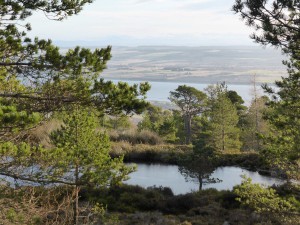 Ge brith dè an fhirinn, mhair an carragh-cuimhne faicsinneach tarraingeach, agus thug iomadh duine ainmeil air tadhail sa Ghàidhealtachd iomradh air, m.e. am bàrd Robert Southey agus am peantair W M Turner (rinn esan sgeidse dheth). Agus dè thachair ri Eachann Rothach fhèin? Bha dithis mhac aige a chaochail roimhe, sna h-Innseachan – chaidh aon dhiubh a mharbhadh le tìgear, am fear eile le siorc. Chaochail Eachann aig Taigh an Fhuamhair ann an 1805, a rèir choltais ag ionndrainn na h-Innseachan fhathast; chaidh an oighreachd dhan nighean aige, a phòs Ronald Ferguson à Raith, agus dh’atharraich ainm an teaghlaich gu Munro Ferguson, an aon teaghlach aig a bheil an oighreachd an-diugh. Agus an t-ainm ‘Fyrish’ fhèin? A rèir eòlaiche ainmean-àite Rois is Chrombaidh, W J Watson, ‘s e ainm Lochlannach no Cruithneach a th’ ann, chan e Gàidhlig no Albais.
Ge brith dè an fhirinn, mhair an carragh-cuimhne faicsinneach tarraingeach, agus thug iomadh duine ainmeil air tadhail sa Ghàidhealtachd iomradh air, m.e. am bàrd Robert Southey agus am peantair W M Turner (rinn esan sgeidse dheth). Agus dè thachair ri Eachann Rothach fhèin? Bha dithis mhac aige a chaochail roimhe, sna h-Innseachan – chaidh aon dhiubh a mharbhadh le tìgear, am fear eile le siorc. Chaochail Eachann aig Taigh an Fhuamhair ann an 1805, a rèir choltais ag ionndrainn na h-Innseachan fhathast; chaidh an oighreachd dhan nighean aige, a phòs Ronald Ferguson à Raith, agus dh’atharraich ainm an teaghlaich gu Munro Ferguson, an aon teaghlach aig a bheil an oighreachd an-diugh. Agus an t-ainm ‘Fyrish’ fhèin? A rèir eòlaiche ainmean-àite Rois is Chrombaidh, W J Watson, ‘s e ainm Lochlannach no Cruithneach a th’ ann, chan e Gàidhlig no Albais.
An ath thuras nuair a bhios sibh a’ dràibheadh seachad air Faoighris, no a’ coiseachd suas an cnoc gus na seallaidhean brèagha a mhealadh, faodaidh sibh a bhith a’ smaointinn air na ceanglaichean eadar ar pìos beag Rois an Ear agus saoghal glòrmhor ach an-iochdmhor na h-Ìmpireachd Breatannaich sna h-Innseachan, agus cuideachd air na fuadaichean agus an èiginn a bha air cùl na h-oighreachdan “leasaichte” a tha rim faicinn san latha an diugh.
*********************************
Fyrish
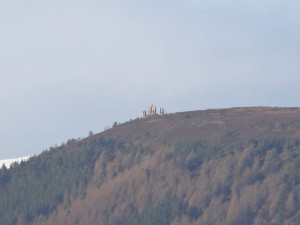 I wrote about Ben Wyvis a month or two ago, and now it’s the turn of Fyrish, the famous hill (1478 ft) with the monument on top, seen behind Evanton and Alness. 2nd January was a beautiful day this year and I walked up to the top with relatives. We weren’t alone up there – clearly half of Easter Ross thought they’d eaten and drunk too much over the last week, and were taking advantage of the lovely weather to get some fresh air and exercise. Or maybe they were implementing one of their New Year’s resolutions?
I wrote about Ben Wyvis a month or two ago, and now it’s the turn of Fyrish, the famous hill (1478 ft) with the monument on top, seen behind Evanton and Alness. 2nd January was a beautiful day this year and I walked up to the top with relatives. We weren’t alone up there – clearly half of Easter Ross thought they’d eaten and drunk too much over the last week, and were taking advantage of the lovely weather to get some fresh air and exercise. Or maybe they were implementing one of their New Year’s resolutions?
Most of us know the bare bones of the Fyrish story – Sir Hector Munro of Novar and his ‘kind’ work-opportunity scheme in the 18th century – but if we do a bit of research, there’s much more interesting background information, linked to Sir Hector himself and to important events in the history of that century.
Hector Munro was born around 1725, and as a young man from a minor branch of the Munro family he served as a regular soldier for the Hanoverians against the Jacobites. One night, by chance, he was able to rescue the Duchess of Gordon from a coach driven by a drunk postillion, and as thanks, she apparently helped him to his first regimental commission. So began his long and illustrious career in the army, much of it spent in India protecting the trade interests of the British Empire (and the East Indian Company).
As commander of the Bengal Presidency Army he helped put down a mutiny by sepoys (Indian soldiers) in 1764, in the brutal fashion of the day: ” No believer in taking a soft line Munro decided that the only way to deal with the sepoys, whether their grievances were justified or not, was to execute the ringleaders in typical EIC fashion – by tying them to the wheels of a cannon and blowing them apart. He also disbanded the most rebellious native regiment.” http://scottishmilitary.blogspot.co.at/2011/08/sir-hector-munro-whos-who-in-scottish.html
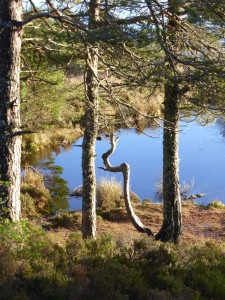 In 1765 he won his most famous victory at Buxar, by implementing brilliant military strategy to defeat 40,000 Mughal soldiers with only 7,000 men. With the prize money he resigned his commission and returned as a hero to Britain. He bought himself a parliamentary seat (‘Inverness Burghs’) and came to live on Novar Estate, which he had inherited from his uncle.
In 1765 he won his most famous victory at Buxar, by implementing brilliant military strategy to defeat 40,000 Mughal soldiers with only 7,000 men. With the prize money he resigned his commission and returned as a hero to Britain. He bought himself a parliamentary seat (‘Inverness Burghs’) and came to live on Novar Estate, which he had inherited from his uncle.
From then on he devoted himself to “improvements” on the estate, as was then the fashion. The land was infertile and treeless, with little work for the locals, and in the next decade or so Munro transformed the houses and the land, improving the soil, planting trees (including the first larches in the area) and also erecting numerous monuments, temples and gates in “Indian” style all over the estate – to the amazement of his more staid neighbours.
Predictably, the money finally ran out, and Munro returned to India in 1777 as commander of the Madras army. This time things didn’t turn out quite as gloriously. He was succesful at Pondichéry and Nagapatnam, but he misjudged the strength of the great army of Hyder Ali, commander of Mysore, and lost the vital battle of Conjeeveram. This was a source of shame to him, and harmed his reputation.
He returned to Scotland in 1782, with slightly less prize money, and began – like many another Highland laird – to introduce sheep to the estate, which caused discontent among the tenants who lost their land and their livelihood – local clearances, as it were. The general (who had quashed the sepoys so harshly 30 years earlier) had no compunction about getting in the army to quell this little rebellion too. But he realised, it seems, that he had to do something for the local people in their distress, although – of course – they would have to work for their money. He saw an opportunity to combine this with commemorating his glorious military career in India in an appropriate way. He already had monuments scattered all over the lower ground, but this one would be built on the highest point of the estate – on Fyrish.
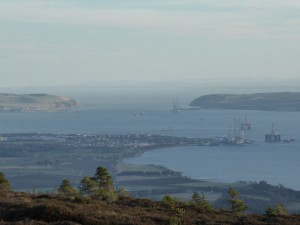 We don’t know whether the workforce was grateful or not, and we don’t know either if the famous story is really true – that the night-shift rolled the stones down the hill that the day-shift had carried up it, to create more work; I hope not. What disrespect for human labour! But we do know that the monument was painted white at first, and that there are two smaller monuments nearby, on Cnoc Ruadh and Meann Chnoc. Originally they were all meant to be connected by a wall, but this never happened – maybe the money ran out again. The monument is also said to be a copy of the city gates of Nagapatnam, but there is no evidence of this. It’s more likely that it’s a generic “Indian”-style erection, like the others on the estate.
We don’t know whether the workforce was grateful or not, and we don’t know either if the famous story is really true – that the night-shift rolled the stones down the hill that the day-shift had carried up it, to create more work; I hope not. What disrespect for human labour! But we do know that the monument was painted white at first, and that there are two smaller monuments nearby, on Cnoc Ruadh and Meann Chnoc. Originally they were all meant to be connected by a wall, but this never happened – maybe the money ran out again. The monument is also said to be a copy of the city gates of Nagapatnam, but there is no evidence of this. It’s more likely that it’s a generic “Indian”-style erection, like the others on the estate.
Whatever the truth, the monument remained conspicuous and fascinating, and many famous visitors to the Highlands commented on it, such as the poet Robert Southey and the painter WM Turner (who sketched it). And what happened to Sir Hector himself? He had two sons who died before him in India – one was killed by a tiger, the other by a shark. Hector himself died in Novar in 1805, apparently still missing India. The estate passed to his daughter who married a Ronald Ferguson of Raith, and the family name was changed to Munro Ferguson – the same family who have the estate today. And the name “Fyrish” itself? According to the expert on Ross-shire placenames, WJ Watson, it’s a Norse or Pictish name in origin, not a Gaelic or Scots one.
So the next time you drive past Fyrish, or climb it to enjoy the beautiful views, remember the links between our wee corner of Easter Ross and the glorious but cruel world of the British Empire in India, and also remember the the clearances and the hardship that were behind every “improved” estate we can see today.
-
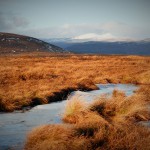
-
Carn Chruinneag from Fyrish
-
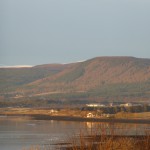
-
Fyrish from Invergordon
-
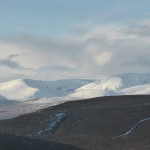
-
Ben Wyvis from Fyrish
Dealbh Eachainn /Sir Hector Munro portrait: Creative Commons http://en.wikipedia.org/wiki/File:Sir_Hector_Munro_by_David_Martin.jpg
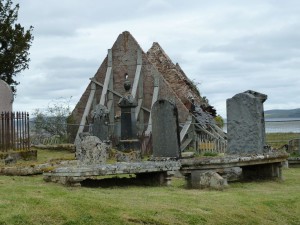 Sgrìobh mi pìos mun t-seann eaglais aig Naomh Mìcheal san Eilean Dubh mu bhliadhna air ais, agus mu na planaichean aca ionad-tadhail eachraidheil a chruthaichadh, nam biodh airgead gu leòr ri fhaighinn. Uill, tha airgead aca a-nis – mu dheireadh thall – bhon chrannchur is tobraichean eile; chan eil gu leòr aca fhathast, ach ‘s e ceum glè chudromach is brosnachail a th’ ann.
Sgrìobh mi pìos mun t-seann eaglais aig Naomh Mìcheal san Eilean Dubh mu bhliadhna air ais, agus mu na planaichean aca ionad-tadhail eachraidheil a chruthaichadh, nam biodh airgead gu leòr ri fhaighinn. Uill, tha airgead aca a-nis – mu dheireadh thall – bhon chrannchur is tobraichean eile; chan eil gu leòr aca fhathast, ach ‘s e ceum glè chudromach is brosnachail a th’ ann.








